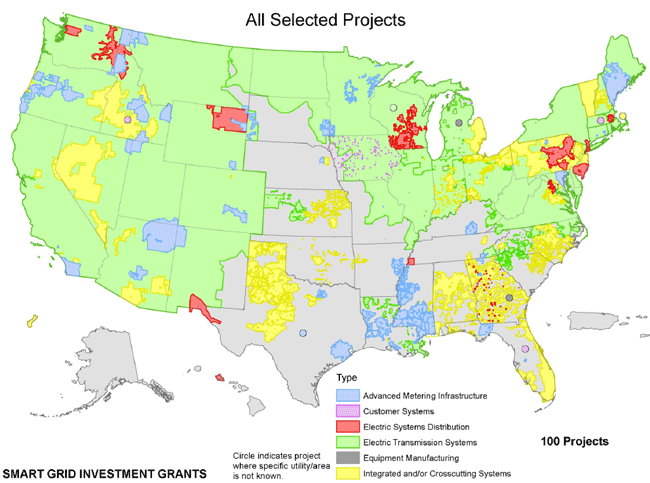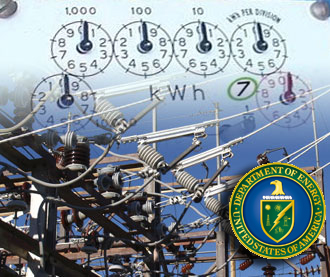
Smart Grid Grants
Public doubts about smart meters — the basic components of a smart grid — are in the news once again.
The New York Times just ran a piece about the “Stop Smart Meters” movement in the San Francisco Bay area. Health and privacy are key concerns there. On the health side of the equation, some people worry about possible negative effects caused by the wireless signals broadcast from smart meters.
From the Times:
The health concerns about the smart meters focus on the phenomenon known as “electromagnetic hypersensitivity,” or E.H.S., in which people claim that radiation from cellphones, WiFi systems or smart meters causes them to suffer dizziness, fatigue, headaches, sleeplessness or heart palpitations. (At a recent Public Utilities Commission hearing on smart meters, an audience member requested that all cellphones be turned off as a gesture to the electrosensitive people in the audience.)
Opponents of smart meters say that wireless systems aren’t necessary for a smart grid. I asked smart grid expert, and author of The Smart Grid Dictionary, Christine Herztog, about that claim.
“Most smart meters in this country are wireless,” Hertzog responded, “while in Europe most are PLC [Power Line Carrier — meaning that the utility lines themselves are used to communicate data].” The problem with PLC, she explained, is that “if the electricity drops, so does the ability to communicate. Wireless – if the electricity drops, the ability to communicate remains until the battery dies.” Large utilities with many distant customers combine wireless and PLC communications.
So, the truth is that smart meters aren’t exactly necessary for a smart grid — but for technical and economic reasons, they’re here to stay.
 But, do wireless smart meters really pose a public health danger? The most-frequently cited study on the issue found that the data “suggested” a correlation between the highest levels of radiation exposure from cellphone use and a type of brain tumor, with the caveat that no causal relationship was found.
But, do wireless smart meters really pose a public health danger? The most-frequently cited study on the issue found that the data “suggested” a correlation between the highest levels of radiation exposure from cellphone use and a type of brain tumor, with the caveat that no causal relationship was found.
What’s more, the amount of radio frequency (RF) current generated by smart meters is relatively low — compared to cell phones, Bluetooth headsets, WiFi routers and the like. That’s mostly because smart meters only send information one or two times a day and even then in low-power bursts lasting only a few seconds. The fact is, most American’s live in an environment that is already permeated by RF current.
While the extra RF generated by smart meters is small, the data they provide could result in a healthier, safer environment according to an article that appeared last year in the journal, Science:
Electricity use in the home is of interest to epidemiologists. Appliance usage may be a main effect variable in epidemiologic studies of health impacts of electromagnetic fields. It may be a confounding variable in studies of air pollution or other causes of disease. Smart meters could provide direct data on use of some appliances (e.g., microwaves and electric blankets), as well as a check on usage data for other appliances obtained from the questionnaires normally used in such studies.
Other types of health studies (e.g., intervention studies) can benefit from access to detailed, individualized electricity data. Algorithms might be designed, for example, to infer how many times per day a refrigerator door was opened (relevant to dietary and obesity studies), the times of day a residence was occupied (relevant to air pollution health studies), and even the pattern of sleep (relevant to a variety of health studies).
Some uses of data may be unknown today, but important decades hence. Saved electricity data may help future generations solve unanticipated problems, just as 1960s satellite images collected before awareness of the climate problem assist us today.
One of the primary benefits of a smart grid is its potential to cut greenhouse gas emissions. A 2010 Department of Energy study concluded that a smart grid, if fully-implemented in the U.S., would lower the nation’s CO2 emissions by 12 percent (with another 6 percent reduction coming from indirect effects).
One of the real risks posed by smart meters is security, writes Christine Hertzog in her blog, The Smart Grid Library.
Everyone agrees that consumers need to be educated about the entirely new types of energy use data that can be created with Smart Grid technologies. While we must ensure that consumers are aware of their rights and responsibilities regarding energy use data, there is less conversation ongoing about educating utilities and vendors to deploy programs to ensure data privacy…
(Her entire post is well-worth reading — it has information that will benefit consumers, vendors, and policy makers alike.)
Indeed, some of the problems PG&E is experiencing with an anti-smart-meter backlash were caused by the failure of the utility to inform customers about its privacy and security programs. That was one of the conclusions of a study commissioned last year by the California Public Utilities Commission (pdf).
On her blog, Hertzog raises an issue that I haven’t seen explored elsewhere: ownership.
The bottom line question is: who owns the value of that energy use data? In the case of investor owned utilities, should regulators insist that proceeds of sales of anonymized energy use data be disbursed to ratepayers instead of shareholders? And in the case of energy service providers, whether a utility or another vendor, there are a range of questions about how that data could be used that must be answered to avoid the mis-steps and abuses of privacy that we have seen from some social media sites.
On balance, smart meters and a smart grid represent a giant step forward — technologically, economically, and environmentally. But, as with any major changes, there are risks. To reap the benefits and manage the risks we have to be at least as smart as the technology we’re embracing.
[This piece first appeared in my Forbes blog, Edison 2.0]


